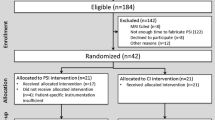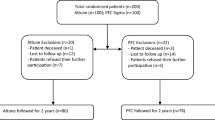Abstract
Purpose
The purpose of this study was to evaluate clinical, functional, and radiographic outcomes following total knee arthroplasty (TKA) performed with patient-specific instrumentation (PSI), computer-assisted surgery (CAS), and manual instruments at short-term follow-up.
Methods
122 TKAs were performed by a single surgeon: 42 with PSI, 38 with CAS, and 40 with manual instrumentation. Preoperative, 1-month, and 6-month clinical and functional outcomes were measured using the Knee Society scoring system (knee score, function score, range of motion, and pain score). Improvements in clinical and functional outcomes from the preoperative to postoperative period were analyzed. Preoperative and postoperative radiographs were measured to evaluate limb and component alignment.
Results
Preoperative, 1-month postoperative, and 6-month postoperative knee scores, function scores, range of motion, and pain scores were highest in the PSI group compared to CAS and manual instrumentation. At 6-month follow-up, PSI TKA was associated with a statistically significant improvement in functional score when compared to manual TKA. Otherwise, there were no statistically significant differences in improvements among PSI, CAS, and manual TKA groups.
Conclusion
The higher preoperative scores in the PSI group limits the ability to draw definitive conclusions from the raw postoperative scores, but analyzing the changes in scores revealed that PSI was associated with a statistically significant improvement in Knee Society Functional score at 6-month post-TKA as compared to CAS or manual TKA. This may be attributable to improvements in component rotation and positioning, improved component size accuracy, or other factors that are not discernible on plain radiograph.






Similar content being viewed by others
References
Hafez MA, Chelule KL, Seedhom BB, Sherman KP (2006) Computer-assisted total knee arthroplasty using patient-specific templating. Clin Orthop Relat Res 444:184
Ng VY, DeClaire JH, Berend KR, Gulick BC, Lombardi AV Jr (2012) Improved accuracy of alignment with patient-specific positioning guides compared with manual instrumentation in TKA. Clin Orthop Relat Res 470(1):99
Nunley RM, Ellison BS, Zhu J, Ruh EL, Howell SM, Barrack RL (2012) Do patient-specific guides improve coronal alignment in total knee arthroplasty? Clin Orthop Relat Res 470(3):895
Spencer BA, Mont MA, McGrath MS, Boyd B, Mitrick MF (2009) Initial experience with custom-fit total knee replacement: intra-operative events and long-leg coronal alignment. Int Orthop 33(6):1571
Nunley RM, Ellison BS, Ruh EL, Williams BM, Foreman K, Ford AD, Barrack RL (2012) Are patient-specific cutting blocks cost-effective for total knee arthroplasty? Clin Orthop Relat Res 470(3):889
Bathis H, Perlick L, Tingart M, Luring C, Zurakowski D, Grifka J (2004) Alignment in total knee arthroplasty. A comparison of computer-assisted surgery with the conventional technique. J Bone Jt Surg Br 86(5):682
Chauhan SK, Scott RG, Breidahl W, Beaver RJ (2004) Computer-assisted knee arthroplasty versus a conventional jig-based technique. A randomised, prospective trial. J Bone Jt Surg Br 86(3): 372
Chin PL, Yang KY, Yeo SJ, Lo NN (2005) Randomized control trial comparing radiographic total knee arthroplasty implant placement using computer navigation versus conventional technique. J Arthroplast 20(5):618
Decking R, Markmann Y, Fuchs J, Puhl W, Scharf HP (2005) Leg axis after computer-navigated total knee arthroplasty: a prospective randomized trial comparing computer-navigated and manual implantation. J Arthroplast 20(3):282
Haaker RG, Stockheim M, Kamp M, Proff G, Breitenfelder J, Ottersbach A (2005) Computer-assisted navigation increases precision of component placement in total knee arthroplasty. Clin Orthop Relat Res 433:152
Jenny JY, Boeri C (2001) Computer-assisted implantation of a total knee arthroplasty: a case-controlled study in comparison with classical instrumentation. Rev Chir Orthop Reparatrice Appar Mot 87(7):645
Sparmann M, Wolke B, Czupalla H, Banzer D, Zink A (2003) Positioning of total knee arthroplasty with and without navigation support. A prospective, randomised, study. J Bone Jt Surg Br 85(6):830
Stockl B, Nogler M, Rosiek R, Fischer M, Krismer M, Kessler O (2004) Navigation improves accuracy of rotational alignment in total knee arthroplasty. Clin Orthop Relat Res 426:180
Hiscox CM, Bohm ER, Turgeon TR, Hedden DR, Burnell CD (2011) Randomized trial of computer-assisted knee arthroplasty: impact on clinical and radiographic outcomes. J Arthroplast 26(8):1259
Harvie P, Sloan K, Beaver RJ (2011) Three-dimensional component alignment and functional outcome in computer-navigated total knee arthroplasty: a prospective, randomized study comparing two navigation systems. J Arthroplast 26(8):1285
Dutton AQ, Yeo SJ (2009) Computer-assisted minimally invasive total knee arthroplasty compared with standard total knee arthroplasty surgical technique. J Bone Jt Surg Am 91(Suppl 2 Pt 1):116
Hernandez-Vaquero D, Suarez-Vazquez A, Iglesias-Fernandez S (2011) Can computer assistance improve the clinical and functional scores in total knee arthroplasty? Clin Orthop Relat Res 469(12):3436
Barrett WP, Mason JB, Moskal JT, Dalury DF, Oliashirazi A, Fisher DA (2011) Comparison of radiographic alignment of imageless computer-assisted surgery versus conventional instrumentation in primary total knee arthroplasty. J Arthroplast 26(8):1273
Martin A, Wohlgenannt O, Prenn M, Oelsch C, von Strempel A (2007) Imageless navigation for TKA increases implantation accuracy. Clin Orthop Relat Res 460:178
Martin A, von Strempel A (2006) Two-year outcomes of computed tomography-based and computed tomography free navigation for total knee arthroplasties. Clin Orthop Relat Res 449:275
Victor J, Hoste D (2004) Image-based computer-assisted total knee arthroplasty leads to lower variability in coronal alignment. Clin Orthop Relat Res 428:131
Matziolis G, Krocker D, Weiss U, Tohtz S, Perka C (2007) A prospective, randomized study of computer-assisted and conventional total knee arthroplasty three-dimensional evaluation of implant alignment and rotation. J Bone Jt Surg Am 89(2):236
Kamat YD, Aurakzai KM, Adhikari AR, Matthews D, Kalairajah Y, Field RE (2009) Does computer navigation in total knee arthroplasty improve patient outcome at midterm follow-up? Int Orthop 33(6):1567
Molfetta L, Caldo D (2008) Computer navigation versus conventional implantation for varus knee total arthroplasty: a case-control study at 5 years follow-up. Knee 15(2):75
Spencer JM, Chauhan SK, Sloan K, Taylor A, Beaver RJ (2007) Computer navigation versus conventional total knee replacement: no difference in functional results at 2 years. J Bone Jt Surg Br 89(4):477
Ensini A, Catani F, Leardini A, Romagnoli M, Giannini S (2007) Alignments and clinical results in conventional and navigated total knee arthroplasty. Clin Orthop Relat Res 457:156
Stulberg SD, Yaffe MA, Koo SS (2006) Computer-assisted surgery versus manual total knee arthroplasty: a case-controlled study. J Bone Jt Surg Am 88(Suppl 4):47
Goebel D, Schultz W (2012) The Columbus knee system: 4-year results of a new deep flexion design compared to the NexGen full flex implant. Arthritis 2012:213817
Yaffe M, Chan P, Goyal N, Luo M, Cayo M, Stulberg SD (2013) Computer-assisted versus manual TKA: no difference in clinical or functional outcomes at 5-year follow-up. Orthopedics 36(5):e627
Yaffe MA, Koo SS, Stulberg SD (2008) Radiographic and navigation measurements of TKA limb alignment do not correlate. Clin Orthop Relat Res 466:2736–2744
Brouwer RW, Jakma TS, Brouwer KH, Verhaar JA (2007) Pitfalls in determining knee alignment: a radiographic cadaver study. J Knee Surg 20(3):210
Hunt MA, Fowler PJ, Birmingham TB, Jenkyn TR, Giffin JR (2006) Foot rotational effects on radiographic measures of lower limb alignment. Can J Surg 49(6):401
Lonner JH, Laird MT, Stuchin SA (1996) Effect of rotation and knee flexion on radiographic alignment in total knee arthroplasties. Clin Orthop Relat Res 331:102
Senden R (2012) High variability in Knee Society Score between studies: how reliable is the Knee Society Score? In: AAOS 2012 annual meeting. San Francisco, CA
Ghanem E, Pawasarat I, Lindsay A, May L, Azzam K, Joshi A, Parvizi J (2010) Limitations of the Knee Society Score in evaluating outcomes following revision total knee arthroplasty. J Bone Jt Surg Am 92(14):2445
Conflict of interest
The authors declare that they have no conflict of interest.
Author information
Authors and Affiliations
Corresponding author
Electronic supplementary material
Below is the link to the electronic supplementary material.
Rights and permissions
About this article
Cite this article
Yaffe, M., Luo, M., Goyal, N. et al. Clinical, functional, and radiographic outcomes following total knee arthroplasty with patient-specific instrumentation, computer-assisted surgery, and manual instrumentation: a short-term follow-up study. Int J CARS 9, 837–844 (2014). https://doi.org/10.1007/s11548-013-0968-6
Received:
Accepted:
Published:
Issue Date:
DOI: https://doi.org/10.1007/s11548-013-0968-6




